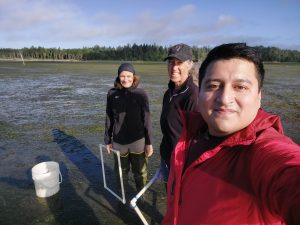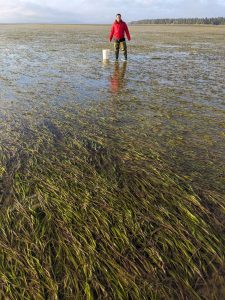WSG-funded research informs the future of eelgrass restoration in Washington
From the Summer 2024 Sea Star
By Erick Dowell, WSG student assistant

(From left) Kerry Naish, Jennifer Ruesink and Bryan Briones Ortiz in the field. Photos courtesy of Kerry Naish, Jennifer Ruesink and Bryan Briones Ortiz.
Beneath the coastal waters of Washington state, if you look in the right spots you’ll find green, grassy meadows. They are not too different from meadows you may want to frolic through on land, but down here the blades of grass undulate with salt water eddies and waves of the sea instead of a gentle summer breeze. Eelgrass (Zostera marina) forms meadows in the muddy bottoms of Washington’s marine bays and shorelines from the intertidal to the foreshore. Although eelgrass lives in the marine environment, it is not a kelp or another type of macroalgae. Eelgrass is a true plant that roots itself in the soft sediment bottoms off the coast. It flowers and produces seeds like any terrestrial plant. Like kelp, though, eelgrass forms dense communities that support a wide array of other organisms like young salmon, crabs, herring, mollusks, shrimp and others. And like the West Coast’s well-known bull kelp (Nereocystis luetkeana), eelgrass is facing population declines, habitat loss and recovery challenges.
Habitat disturbance from development, agricultural practices and industrial use in coastal areas and upland watersheds disrupts the clean and clear waters in which eelgrass grows best. Direct disturbances from vessel anchors and propellers or overwater structures like private docks tend to destroy beds or block the sunlight that eelgrass needs to grow. These threats and resulting declines have prompted the Washington Department of Fish and Wildlife to list eelgrass as a species of special concern. Further, eelgrass’s unique importance to the coastal ecosystem has led to the species’ listing as critical habitat by Washington Department of Ecology’s Shoreline Management Act. Conservation and restoration of this species has become an important part of the state’s plans, so much so that Washington recently passed legislation creating a statewide kelp and eelgrass health and conservation plan. The plan aims to conserve and restore at least 10,000 acres of kelp and eelgrass in the state. But how do we protect and get these eelgrass meadows to grow? A research project funded by WSG is trying to find out.
The WSG study is headed by Kerry Naish and Jennifer Ruesink, respectively University of Washington professors in Aquatic and Fishery Sciences and Biology, as well as doctoral student Bryan Briones Ortiz. Their research first looked at the baseline genetic structure of the eelgrass population in Washington state. You can find eelgrass meadows from south Puget Sound up into the San Juan Islands and in the bays along the outer coast. The questions the researchers asked were: are these meadows all very closely related or nothing alike? Is each population very diverse or fairly homogenous? Will eelgrass from one bay adapt to grow in other locations?

Briones Ortiz in an eelgrass meadow.
“To make good decisions about which donor populations to use, and which investments to make in restoration, it helps to know the population genetic structure” says Ruesink. “[It] allows managers to make better decisions about conservation and restoration.”
Surprisingly, it turns out that the eelgrass populations in the state are genetically distinct from each other. This means that, genetically, eelgrass found in Grays Harbor and Willapa Bay is different from eelgrass in Puget Sound. Even among the populations in the Sound, the meadows in south Sound are distinct from the ones in Hood Canal and in north Sound. The distinctiveness of eelgrass populations in Washington indicates that managers will have to be selective when choosing sources for meadow rebuilding projects.
Eelgrass is a special plant species that can have either an annual life cycle or a perennial life cycle depending on the environment where the plant is growing. Another surprising insight from the research project is data showing that annual and perennial eelgrass plants are genetically distinct. “If you take a walk in Willapa Bay and walk out onto the tidal flat, you’ll see this transition between an annual bed and a perennial bed and then another annual bed. The annuals tend to grow in more extreme environments, so have more desiccation, more exposure to the sun. Whereas perennials tend to be in more stable environments,” Naish explains. “People have thought for ages that those two life history strategies are interchangeable, but based on the work we’ve done, it turns out that they are not, at least in this area.”
To take the study further, Ruesink took seedlings from annual and perennial plants and swapped their locations, so annual seedlings were growing in an area where perennial plants were found. The surprising result was that they both kept their distinct life history strategies — the annuals stayed annual, and the perennials stayed perennial. This result was repeated when the experiment was done again with annual seeds planted in a perennial bed. Briones Ortiz then studied the genetics of eelgrass displaying the two life histories. The results showed that annual and perennial life history types were genetically determined, yet the annual and perennial plants within a region were more closely related to each other than to plants elsewhere in the state. The fact that they have been found in many regions, combined with each region being genetically distinct, suggests that annual life histories have evolved more than once. Briones Ortiz also found that some perennial beds can have up to 97 percent clonality, meaning a single eelgrass plant has asexually spread out to create almost an entire meadow.
“This could have implications for conservation. Maybe this is a resistant genotype that’s doing well,” says Briones Ortiz. Many of the other results from this study also show implications for conservation measures, and the conclusions from these studies will help inform the next steps in restoring eelgrass in the state.
“The eelgrass researchers are asking, ‘if we want to recover our population, which plants should we be using?’” says Naish. If the geography of the eelgrass population matters, and whether the eelgrass is perennial or annual matters, what else needs to be considered as the state works to conserve and restore eelgrass populations? In Washington, even eelgrass that is geographically and genetically close can look fairly different. This group’s current experiments are also exploring whether these physical differences are important when considering conservation and restoration plans.
This work represents the first step toward gathering knowledge needed for Washington state’s eelgrass conservation and restoration goals to be met. Eelgrass is a key player in the foundation for healthy coastal ecosystems in the state. The novel knowledge being collected by this research team will help conserve and grow eelgrass meadows in the future.
###
Washington Sea Grant, based at the University of Washington, helps people and marine life thrive through research, technical expertise and education supporting the responsible use and conservation of coastal ecosystems. The National Sea Grant College Program is part of the National Oceanic and Atmospheric Administration, U.S. Department of Commerce.
Join the conversation: instagram.com/waseagrant and Facebook.com/WaSeaGrant.
AUG
2024